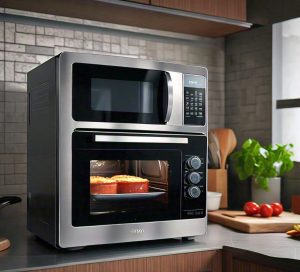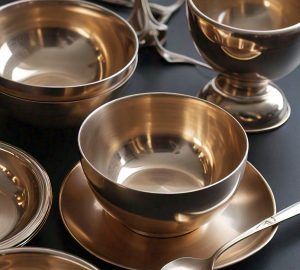A convection microwave is a type of kitchen appliance that combines traditional microwave technology with convection cooking, allowing food to be cooked quickly and evenly.
The question at hand, however, is whether or not one can put metal in this specialized form of microwave.
This article covers everything you need to know about using metal in a convection microwave. We will delve into the specifics of what constitutes a convection microwave; their design and functionality, as well as address the core query – if it’s safe to put metal inside them or not. If it is permissible, we’ll discuss how long you can safely do so without damaging either your appliance or the utensils involved. Conversely, if it’s not recommended, we will provide alternatives for heating food items in such microwaves along with precautionary measures to take while doing so. Expect answers to frequently asked questions (FAQs), additional tips regarding the usage of metals in such appliances and our final word on this topic by the end.

Jump To:
Is it Safe to Put Metal in a Convection Microwave?
No, you cannot put metal in a convection microwave. Metals reflect microwaves and can cause arcing or sparks which may damage the appliance or even start a fire. It’s also important to avoid using foil or metal utensils with similar reflective properties. Instead, opt for microwave-safe materials like glass and ceramics when heating food in a convection microwave.
Facts About Putting Metal in a Convection Microwave
Here we will discuss the important things to note about putting metal in a convection microwave.
- Metal Objects: In general, putting any form of metal objects such as aluminum foil, mugs with metallic paint or trim, and any type of cookware made from metal is not recommended inside a microwave.
- Safety Concerns: The use of metal can cause sparks due to the reflection of microwaves off the surface. This may lead to fires or damage the microwave itself.
- Microwave Design: Microwaves are designed for waves to bounce around within them until they’re absorbed by food; when they hit something like a piece of metal, they get reflected instead which can pose safety risks.
- Convection Feature: While some convection microwaves allow certain types of metals for baking purposes due to different heat circulation processes, it’s always important to refer back to your product manual for specifics.
- Browning Sleeves: The only exception might be those browning sleeves that come with prepackaged foods like hot pockets. They have a thin layer of aluminum that’s been specially treated so it doesn’t arc or spark during cooking. But even these should never be used more than once.
In conclusion, although there could be a few exceptions depending on the specific features and design elements incorporated into your appliance model , it is generally considered unsafe and potentially damaging to put metals inside any kind of microwave oven.
Now let’s discuss other topics related to microwaving metal.
What are the Alternatives to Microwaving Metal in a Convection Microwave?
While microwaving metal in a convection oven is not advised due to safety concerns, there are several alternatives. You can use microwave-safe plastic or glass containers for heating your food. Another option could be conventional ovens which distribute heat evenly and maintain consistent temperatures. Lastly, you might consider using cookware like ceramic dishes which are both safe and effective at preserving the integrity of your food.
Tips to Microwave Safely without Using Metal
To ensure safety while avoiding the use of metals in a convection microwave, consider these tips:
- Prioritize using only containers explicitly marked as ‘Microwave Safe’.
- Avoid using metallic trimmings on bowls or plates within the appliance.
- Ensure that no aluminum foil is present during cooking operations.
- Choose ceramics over plastics when possible because it better conserves heat and helps prevent uneven cooking/firing.
- Always cover your food with a microwave-safe lid or wax paper to avoid splatters and messy cleanup tasks afterwards.
In this section, we discussed some important considerations for anyone looking to safely operate their convection microwave oven without involving metals.
Check out if a convection oven can replace microwave.
In our next session, we will address commonly asked questions about this topic further enhancing our understanding regarding it.

Frequently Asked Questions (FAQs)
In this section, we will now look at the most commonly asked questions related to using metal in a convection microwave.
Can you put metal in a convection microwave?
No, you cannot put metal in a convection microwave. When you place metal objects in a microwave, it can cause sparks due to the reaction of microwaves with the metallic surface. These sparks might damage your oven or even lead to more dangerous situations like fire hazards.
What happens when metal is placed inside a convection microwave?
If you put metal inside a convection microwave, it may lead to sparking or arcing due to interactions between microwaves and metals. The reflected waves could potentially damage the appliance’s interior or even result in fires.
Is it safe to use aluminum foil in a convection microwave?
No, using aluminum foil inside the oven while operating in ‘microwave mode’ isn’t safe as it could spark and cause potential damage. However, when used cautiously during ‘convection mode’, it might be relatively safer but still not recommended.
Can stainless steel be heated up safely within a conventional microwave?
No, similar risks apply with stainless steel items too; they aren’t supposed to be heated up within conventional microwaves because of potential fireworks that can harm both machine and user alike.
We hope answering these FAQs has been helpful in understanding safety guidelines about what materials are suitable for use within your appliance.
Final Word
In conclusion, remember that putting any type of metal into your convection microwave is strongly discouraged by manufacturers due to potential fire hazard situations which could occur from reflected waves causing sparks on contact with such surfaces. It’s crucial to follow safety guidelines for your appliance in order to prevent unnecessary damage and ensure optimal performance.



